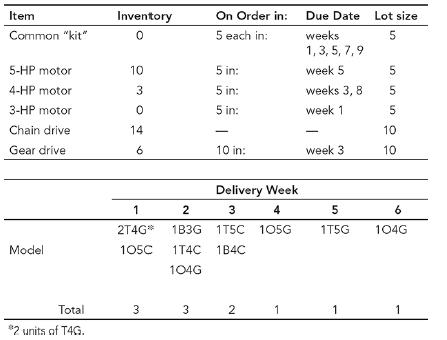10. The Parker Corporation produces and sells a machine for tending golf course greens. The patented device...
Question:
10. The Parker Corporation produces and sells a machine for tending golf course greens. The patented device trims the grass, aerates the turf, and injects a metered amount of nitrogen into the soil. Machines are marketed through the Taylor Golf Course Supply Company, under the Parker Company’s own original equipment brand, and, recently, through a lawn and garden supply house (Brown Thumb), which serves both commercial and consumer accounts. Addition of the lawn and garden outlet and requests to add a 3-HP version have called into question the production planning and control process for the machines.

Forecasting the products to be produced is difficult. There are now two drive mechanisms (chain and gear), three different body styles (one for each outlet), and two engine sizes (4- and 5-HP). This gives a total of 12 end items, all of which had some demand. (See Exhibit A.) The 3-HP motor would add six more end items. Forecasting demand for these new items would add to the difficulty of forecasting demand.
Lead times for some of the castings (gear or chain) and for 5-HP motors have increased to the extent that it is not possible to wait until firm orders are received for the end items before the castings and motors have to be ordered. In addition, the firm’s business is growing; it anticipates selling about 120 units next year. Consequently, the production manager has arranged to purchase enough material for 10 units per month. There is plenty of capacity for the small amount of parts fabrication required, but assembly capacity must be carefully planned. The current plan calls for assembly capacity of 10 units per month.
With regard to the specific issue of forecasting, the marketing manager summarized the data on the sales of each end item over the past year. (See Exhibit A.) He felt that a 20 percent growth in total volume was about right and that 3-HP machines will perhaps account for half that growth. Of course, once the forecasts were made, the production manager had to determine which motors and castings (gear or chain) to order. Each machine was made up of many common parts, but the motors, chain or gear drive subassemblies, and bodies were different (though interchangeable).
a. Suggest an improved method of forecasting demand for the firm’s products.
b. As the production manager contemplated the difficulty of forecasting demand for the firm’s products and determining exactly what to schedule into final assembly, two customers called. The first, from Taylor, wanted to know when the company could deliver a model T3G;
the second wanted as early delivery as possible of one of Parker’s own machines, an O4C. The Taylor representative said he felt that the threehorsepower models might “really take off.”

Before making any commitment at all, it was necessary to check the material availability and get back to the two customers. It was the firm’s practice not to promise immediate delivery, since units scheduled for final assembly were usually already promised. The planned assembly schedule called for assembly of three units next week, two units the following week, and alternating three and two thereafter. As a matter of practice, all parts for assembly and delivery in any week would need to be ready at the start of that week.
Exhibit B shows current inventory and on-order positions for the common part “kit,” the motors, and the drives. (The production manager did not concern himself with the body styles because all three styles can be obtained in a week.) Booked orders promised for delivery over the next few weeks are also listed. Organize this information to respond to the delivery promise requests. (Assume that no safety stocks are held.) What should the delivery promises be?
Step by Step Answer:

Manufacturing Planning And Control For Supply Chain Management The CPIM Reference
ISBN: 9781265138516
3rd Edition
Authors: F. Robert Jacobs, William Lee Berry, D. Clay Whybark, Thomas E. Vollmann






